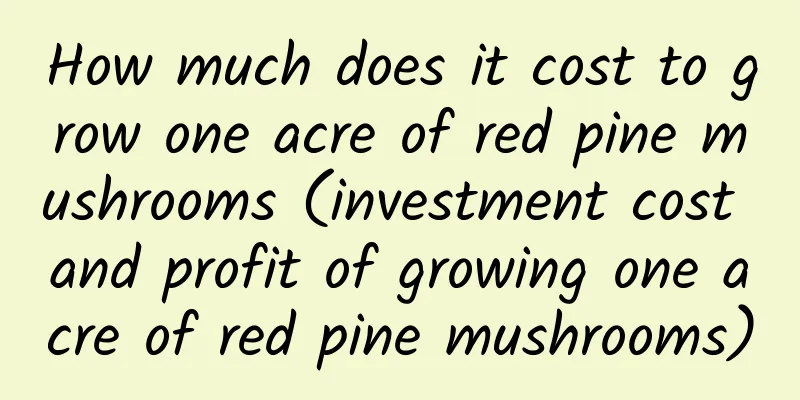How much does it cost to grow one acre of red pine mushrooms (investment cost and profit of growing one acre of red pine mushrooms)

|
Red pine mushroom, scientifically known as Agaricus bisporus, is a large grass-rotting fungus. It has bright color, fragrant taste, smooth meat and rich nutrition. It is a delicious food that combines shiitake mushroom, Agaricus bisporus and Straw mushroom in one. Cost and profit of growing one acre of red pine mushroomThe cultivation cost of red pine mushroom is low and the risk is small . The cultivation cost per mu is about 4,000 yuan . Depending on the level of technical mastery, the yield per mu can reach 4,000 to 8,000 kilograms. The growth temperature of red pine mushroom is 5-26 degrees. Through three simple steps, you can obtain considerable economic benefits. It is easy to manage and is completely suitable for planting in northern regions. It costs about 20 yuan per kilogram, and the income per mu will reach 30,000-60,000 yuan. Methods and techniques for growing red pine mushroomsPlanting site selectionChoose a black plum forest with convenient transportation, good ventilation, sufficient water source, convenient drainage and irrigation, away from pollution, 3 to 5 years old or with a canopy density of about 0.75, and a slope of ≤ 50 degrees. Bacteria productionThe best mother culture formula is the comprehensive potato culture medium: 200 grams of potatoes + 1000 ml of water + 20 grams of glucose + 20 grams of agar + 1.5 grams of potassium dihydrogen phosphate + 1.5 grams of magnesium sulfate, pH 7-8. Prepare according to the conventional method, place it in a constant temperature culture at 20-25°C after inoculation, and the mycelium will begin to germinate after 1 day. The mycelium is white and dense, and it will cover the slope in 7-10 days. Selection and processing of culture mediaRice straw, corn cobs, rice husks, sawdust and other agricultural and forestry by-products can be used to cultivate Stropharia rugosa. The raw materials must be fresh, dry, free of mold, lumps and insects. Land preparation and pavingThe land is prepared and ridges are made. The ridge surface is 80~100 cm wide, the ditch width is 40 cm, and the ridge bed length is determined according to the terrain. One week before sowing, disinfect the bed surface with lime powder and spread the mixed culture medium on the bed surface with a thickness of about 15 cm. sowingThe amount of material used is about 15 kg/m2, the amount of seeds used is about 1 bag/m2, and hole sowing or layer sowing is adopted. Layer sowing, break the fungus into 1 cm pieces and divide them into two layers. In the first layer, sow less fungus in the middle and more around. In the second layer, evenly distribute the fungus on the surface of the material. For hole sowing, break the fungus into 2 cm pieces, flatten and compact the bed surface material, then dig holes on the surface of the material, and cover the fungus with culture medium after sowing. Harvest5 to 7 days after budding, when the gills of the fruiting body have not broken and the cap is bell-shaped, it is the right time to harvest. When harvesting, gently twist the mushroom feet with your hands, pull them upwards after loosening. Fill the soil in time for fungus fermentation after harvesting. Spray heavy water after 7 days to stimulate mushroom production. 3 to 4 flushes of mushrooms can be harvested during the entire growing period. |
>>: How often should roses be watered?
Recommend
How to deal with calla lily root rot
1. How to deal with it 1. Reasons First, it may b...
Does June Snow prefer shade or sun?
Does June Snow prefer shade or sun? June snow is ...
Leek seed germination method
Before germinating, leeks should be rinsed with c...
The language and legend of cockscomb
The Flower Language of Cockscomb The inflorescenc...
The growing environment and local conditions of lilies
Lily Growth Environment and Conditions Lily grows...
How to prune pine needles
When is the best time to prune pine needles? It i...
How long does it take for a mountain cymbidium to adapt to the pot, and how many years can it bloom?
1. How long does it take for the cymbidium to ada...
Can pumpkin seeds be planted directly?
Can pumpkin seeds be planted directly? Pumpkin se...
Formula and preparation method of water-soluble fertilizer
Water-soluble fertilizer is a kind of fertilizer ...
Fruiting of Figs
When do figs bear fruit? Fig is a common fruit tr...
Introduction to the types of creepers
Introduction Ivy: Parthenocissus genus, Vitaceae,...
Can succulents be grown in coconut bricks?
Can coconut bricks be used to grow succulents? Co...
Planting and cultivation techniques of honeysuckle
Honeysuckle, also known as double flower or honey...
What is the best fertilizer for broccoli?
Broccoli fertilization time Broccoli has relative...
Long beans planting time and method
Long beans planting time Long beans are generally...









